Artist “Authors, Artists, and Makers Volume 7: Brent Cotton”
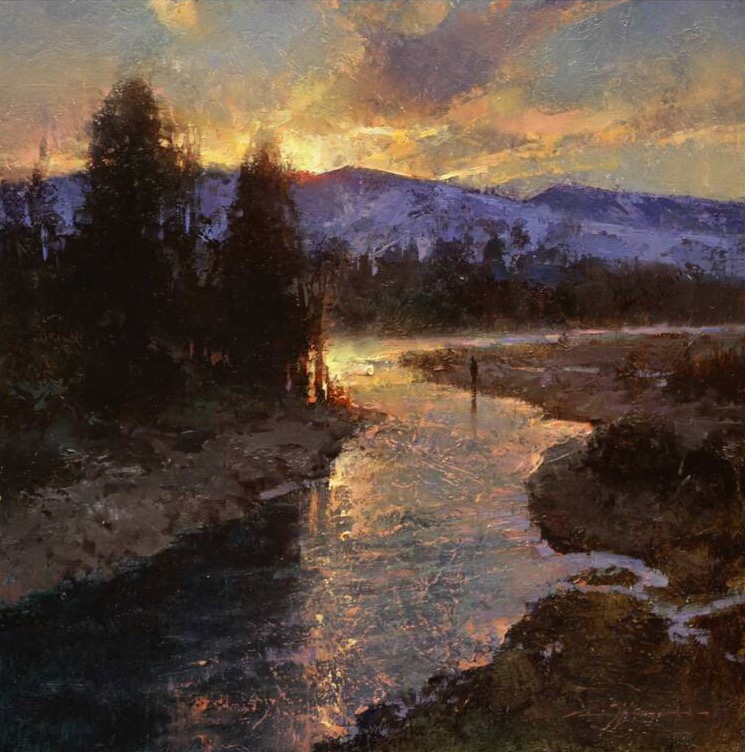
I’m always astounded by certain artists’ ability to capture the intrinsic beauty of the “every day”—whether through words or images or sculptures or musical notes combined just so. Works that make me feel something deep and raw, or bring to mind beautiful moments sometimes lost behind the gauze of time. That can, in an instant, make me heavy or light. Or smile, or laugh, or cry. Works that arrest me, quicken my pulse, or make the hairs on my arm stand up.
One of the most difficult accomplishments in painting, I believe, is capturing light in a way that rings true; that feels authentic, able to pull the emotion out of a single moment. If you are anything like me, you can probably harken back to the glow of a western sunrise washing the mountains pink just outside your tent door, or recall last light hitting the river in that inexplicable golden tone that the Japanese call Kawaakari, or the burnt-amber flicker of a campfire dancing wildly on the forest flora, or the full winter moon boldly illuminating fresh snow in hues of whites and blues that words can’t quite reach. But, capturing these moments—this light—is an entirely different matter. I often find myself, like so many others, apologetically explaining that “my photos don’t do it any justice.” And they never do.
When I first came across the work of Brent Cotton, I was mesmerized. By the lighting. By the moodiness. By the moments perfectly captured and retold through oil and brush and canvas. I remember the first featured a man tending a fire in the woods. It was haunting. I can’t even explain why, but it was like nothing I had ever experienced. I found myself staring. Completely transfixed. Hypnotized by the flames. I went on to explore more of his work—scenes on rivers and in woods; of rural and wild beauty. Places I wanted to be. Places that felt familiar and intimate. And the light; always the light. Rendered in that perfect form. It grabs me, pulls me in close, and beckons me to stay a spell.
I was excited to talk to Brent and learn his story—which like so many immensely talented artists is as interesting as the work itself. I appreciate him sharing it with me and allowing me, in turn, to share it with you here. Enjoy.
Q: Brent, you grew up on a cattle ranch in Idaho. Can you talk about those early years and maybe hit on what parts of that influenced the work/person you are today?
A: “My family’s ranch has been in operation since the 1870’s when my great great grandparents settled in the Blackfoot river valley of southeastern Idaho. It was a wonderful place to spend my young childhood; riding horses, building forts in the woods, dunking worms in the Blackfoot river in the hopes of catching an elusive cutthroat trout but more likely reeling in a sucker. The brandings, cattle drives, and summers spent moving sprinkler pipe instilled a love of ranching and farming and the feeling of accomplishment that a hard day’s work can provide. I still draw upon those formative years for ideas in my paintings and I think as I grow older I’m appreciating the quieter scenes of rural life and seeking out ways to portray these mundane activities and experiences in a new or meaningful way.”
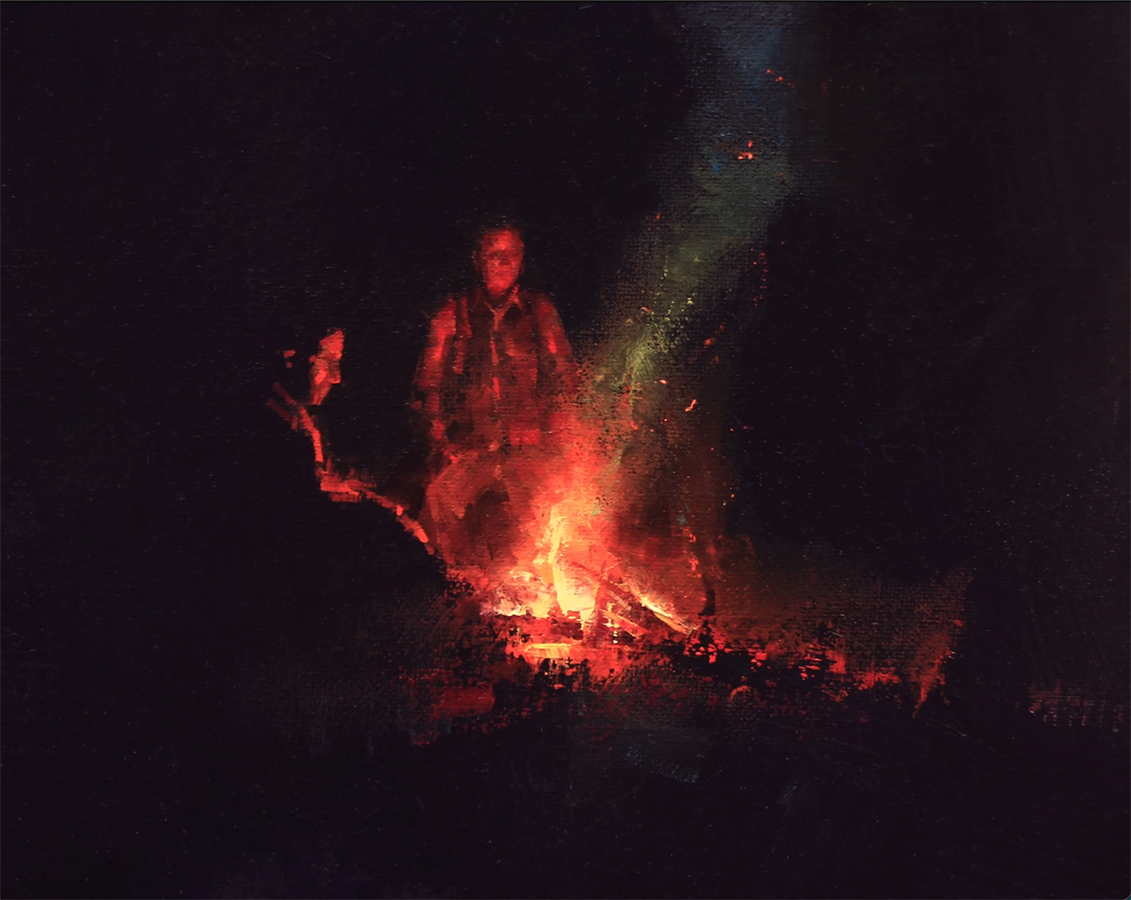
Q. You mention a few different influences in the arts at various points in your development as an artist including your grandmother, a high school instructor, and Christine Verner—can you talk a little about each of those influences and how they shaped you or perhaps changed your trajectory?
A: “My grandmother, Alma, was an amazing lady, a mother of seven including my mom. Always busy with the various day to day chores of ranch life but she made time to pursue her artistic interests and was quite an accomplished watercolorist in particular. She was my first art teacher and always encouraging to myself and the rest of the cousins that called the ranch home. Her large dining room table was frequently the scene of frenetic activity when she’d roll out the butcher paper and let us attack it with markers and colored pencils. Years later I had the honor of having her sit behind me during one of my quick draws at a major show; she even held the hecklers at bay. Haha. She’s passed on now but her legacy lives on and I’m so grateful for the love of art that she instilled in me.”
“My family moved from the ranch when I was in 5th grade to the small Swedish farming community of Lindsborg, Kansas. It was quite a change to leave the Idaho mountains behind for the flatlands, and the trout streams for the bass ponds, but I adjusted. I feel very fortunate that the arts were celebrated in that school system. Gary Sechrist was my high school art teacher and he fostered my love of drawing and also introduced new mediums to me. Dabbling in oils and acrylics for the first time was eye opening. He allowed me to have one period in the art room all to myself my senior year so he could pass along more of his knowledge. I think he saw in me some raw ability and real desire to move forward into an art related career. Through social media I still keep in touch with him and I’m not the only artist that has come out of his program and into art careers, several others including wildlife artist Chip Brock are making a living with their art.”
“Fast forward from high school a few years I met a woman from Oklahoma at a workshop in Montana named Christine Verner and that chance meeting led to a several-year apprenticeship with her at her home and art studio in McAlester, Oklahoma. Through her generous tutelage I gained a much broader understanding of not only technique but also art history and I truly credit her with helping put me on the path I’m on now as a successful fine artist.”
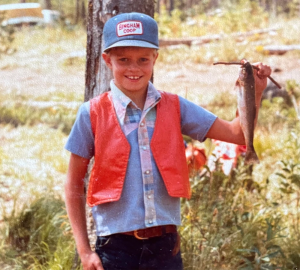
Q: Guiding—you spent some years in Idaho and Alaska as a hunting and fishing guide. What lead you down that path? What are some life lessons you learned from those experiences?
A: “I’ve always had a love for the outdoors and being immersed in nature. Pursuing the next adventure and wanting to see what’s around the bend has always excited me. Reading tales of exploration, survival, and sporting pursuits in the wild made me want to get out there and experience some of that myself. I knew I wanted to work in the outdoors in some fashion, combining my love of hunting and fishing with my interest in art, so after reading an ad in the back of Outdoor life about a guide school out west, I thought why not? A month after graduating from high school I found myself along the Green River in Wyoming learning how to shoe horses, pack mules and guide hunters for elk and deer. Coming straight from Kansas this was like entering heaven, with the grandeur of the Wind River range, and rivers full of cutthroat trout surrounding me.”
“After graduating from that month-long school I was hired by the Salmon River Lodge in the Frank Church Wilderness of Idaho. I worked two seasons in that very rugged and remote country as a mule packer and assistant guide. It was tough work of course, but for an 18-year- old kid I thought I’d won the job lottery! I had my share of mule wrecks and “character building” experiences, including one snowy night rescuing a lost hunter from another lodge that surely would have perished had I not found him. I guess I felt like most young folks do at that age that I was invincible and I could take on the wilderness without much difficulty but I had some growing up to do that’s for sure. Being around the seasoned guides and clients was an educational experience that can’t be taught in school. Those memories still provide inspiration and ideas for future works.”
“Following my hunting season adventures in Idaho, I had the opportunity to work for a lodge in Alaska as a fishing guide. The two seasons I worked there were truly epic. Flying around in a float plane, fly fishing for several different salmon species and enormous trout, hunting for caribou and moose. What a grand adventure that was. Both of those early guiding jobs taught me the value of hard work, the appreciation for wild spaces and the game that inhabits it, and the satisfaction of helping others enjoy the experience.”
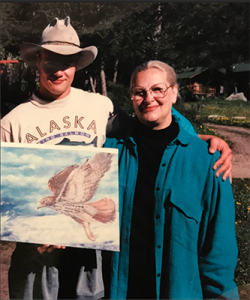
Q: You moved to Maui in 1999. That must have been quite a change. What led to that and what role did that experience play in the bigger picture?
A: “After I left Oklahoma in 1998 having spent several years studying with Christine Verner I decided it was time to strike out on my own and see what I could do with my art. I had a fellow artist friend who was living on Maui at the time and needed someone to share the rent so he reached out to me. Being a struggling artist on the beaches of Hawaii didn’t sound too bad so I jumped at the chance. I supported myself by doing plein air landscape paintings near the fancy resorts of the ocean sunsets, palm trees, etc. and selling them to tourists who would walk by. That actually worked better than expected but then again I was only charging about $50 for a 8×10 original oil painting (granted, I wasn’t that good back then). I often wonder how many of those paintings survived the trip home in the suitcases of the folks that bought them.”
“Toward the end of my schedule stay on the island I met a girl from Montana, of all places, and we quickly fell in love and got married (Maui’ed) and spent four years on the island before making the decision to move back to the mainland. The years spent on Maui really did shape the style of art that I was creating. We lived at about 4,000 ft elevation on the slopes of Haleakala volcano and almost every afternoon the clouds would descend and our home would be enveloped in mist. The mood and mystery that it imparted to the landscape really inspired me to create works that also had those qualities. I found myself moving in a more tonal direction and leaving out the detail and extraneous elements that really didn’t add anything to the piece. I was finding my works had more feeling to them and that excited me. Fortunately the response to this new direction was encouraging and I started to gain a following on both the island and the mainland for these moody contemplative works.”
Q: What does today look like? Sounds like you and your young family call the Bitterroot Valley home. Painting, fishing, raising a family. What else?
A: “My wife (Jennifer) and I moved back to Montana in 2004 wanting to be closer to both our families and start a family of our own. As lovely as Hawaii is, it never really felt like home. I was homesick for the snowcapped mountains and the trout streams. So we settled near the little town of Stevensville where my parents were living at the time and bought our own little piece of the Big Sky. Today we are raising two children, a couple horses and a small brood of chickens. My studio is located 20 yards from the house so the commute to work ain’t too bad. ;)”
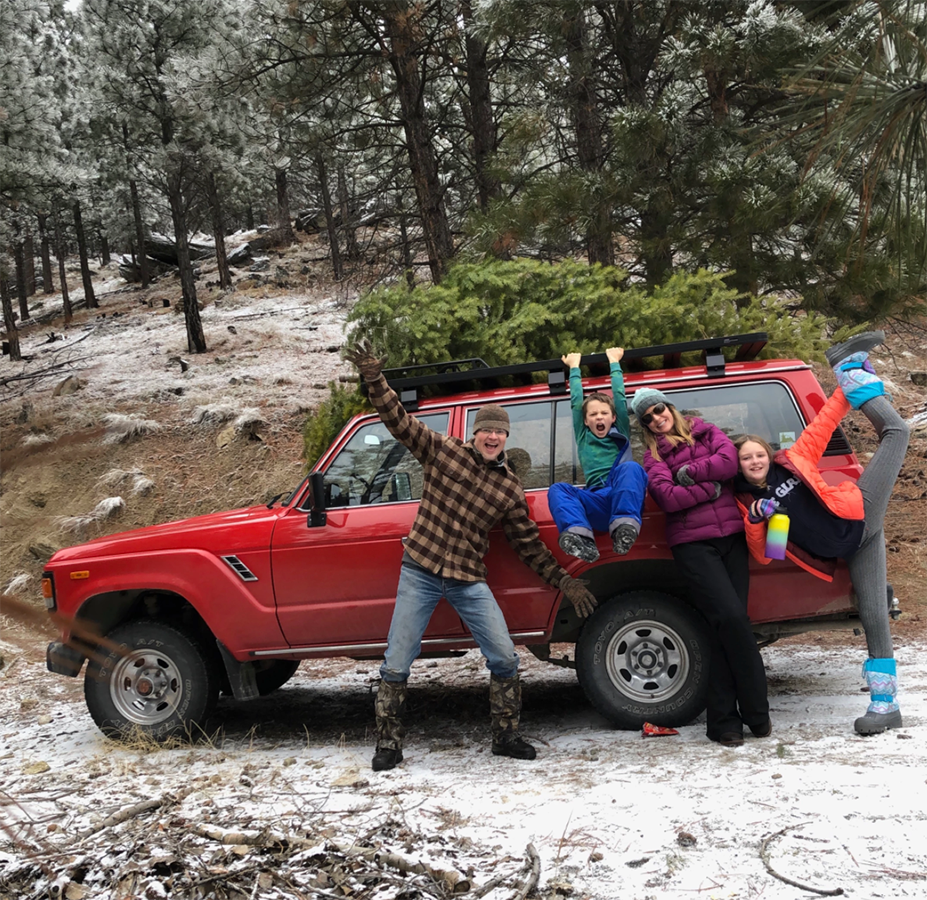
Q: You’ve been able to live in a number of beautiful places, including where you currently call home. Has there been a favorite and why? You ended up back “in the West”—I’m sure there’s a reason?
A: “I guess I kinda already answered this but being close to family both here in Montana and in Idaho is important to us. The outdoor lifestyle is something we crave and want to raise our kids up appreciating. The combination of a small town atmosphere, agricultural heritage, and opportunities for sporting pursuits feed my soul and creative spirit. I feel so fortunate to be able to live in an area where subject matter is all around me and I’m never at a loss for ideas.”
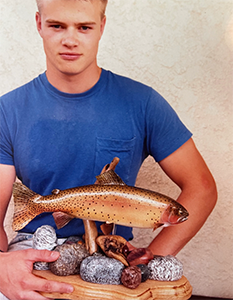
Q: Carving and Sculpting—You spent a number of years carving and sculpting, what led to the change in mediums? Do you still pursue these passions?
A: “Yes before I really learned to paint I taught myself woodcarving, specifically fish and birds. I have always felt more naturally inclined to 3D work so that’s what I gravitated towards early in my career. The first pieces I ever showed in a gallery were my fish carvings. I thought I was gonna take the carving world by storm but after a few years of doing it and living with my parents I realized that I wasn’t going to be able to make a living from it unfortunately. It was upon this realization that I started taking painting workshops and once that started to take off for me I never picked up the carving tools again. I am getting the itch to get back into sculpting but this time I want to try my hand at bronze or possibly even stone.”
Q: You obviously have a passion for fishing. How does that influence your work? Do you find any similarities between the “art” of fishing and the art of painting? Is there a common thread between the two that attracts you?
A: “My wife jokes that I’m a full time fly fisherman who takes time off to paint now and then. It is a pretty true statement although I don’t spend as much time on the water as I would like. When I’m fishing I find myself thinking about how to recreate that lighting effect I’m witnessing, or how I can replicate with paint the mist lifting off the river in the early morning. When I’m at the easel I can picture the coolness of the water on my legs and the feeling of getting the perfect drift and the anticipation of the take. I think I find the artistry of fly fishing appealing because you never really quite master it, just like painting; and trout don’t seem to live in ugly places, so where I find great fishing I also find wonderful subject matter. There’s a Zen magic that happens when the casting rhythm lays the line out perfectly, setting the fly on the water in just the right spot, kinda like when a brushstroke is applied in just the right fluid way to say exactly what you want it to say.”
Q: Without giving away too many secrets, what is your favorite place to fish? Favorite species to pursue and why?
A: “The Bitterroot River is my home river and is my go to for both wade fishing and floating. Learning this river has become a lifelong passion and I really enjoy all of it’s character and seasons. The other fabled rivers in my part of the world (Clark Fork, Rock cCreek, Big Hole, Blackfoot) also call me to them, not to mention the myriad of smaller tributaries and high mountain lakes that would take several lifetimes to explore. I’m a lover of trout, in all varieties and just as happy to hook an eager scrappy little 8” cutthroat on my bamboo rod and dry fly as I am tangling with a hangry brown on an articulated streamer. My limited saltwater fly fishing experience has also given me a glimpse as to how addictive that can become and I look forward to doing more of that in the future.”
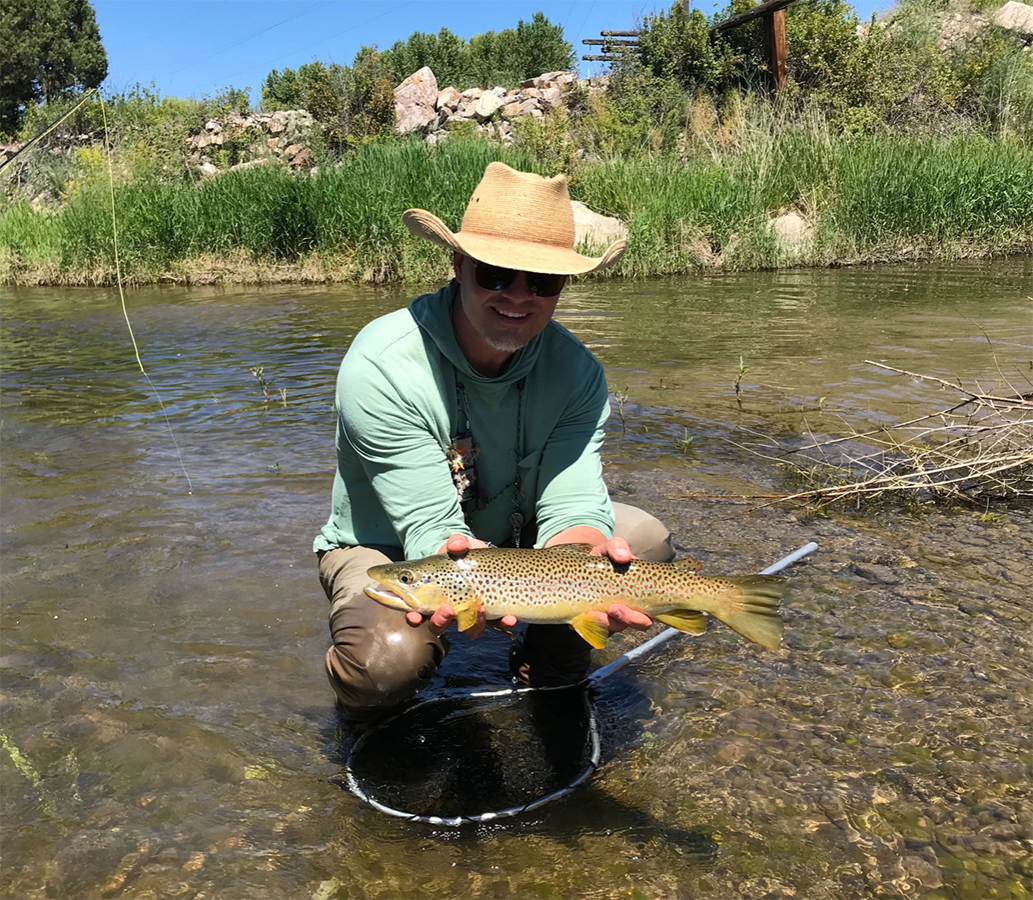
Q: Do you tie?
A: “Yes, I’ve been tying since in was in my teens and really enjoy it. I made my own balsa bass poppers back in Kansas when I was the only one of my friends who fly fished in the ponds there. I’ve started to teach my kids how and enjoy passing that on to them. When I was guiding I would tie all the flies for the clients at the lodge and have developed a few patterns of my own that seem to work, which is always satisfying. Nothing better than catching fish on flies you’ve tied and rods you’ve built.”
Q: Do you still hunt? What is your game of choice?
A: “I hunt more now than I have in the past and now that my son is of hunting age it’s something special we share to bond and build memories together. I picked up a longbow a few years back and have worked hard on becoming proficient with it, harvesting several whitetails but the elk have eluded me thus far. I’m also in the process of building a flintlock rifle to take advantage of the new primitive muzzleloading season here in Montana. I don’t know what it is about me but I like to pick the hardest ways to do stuff. My family and friends don’t really get it. ;)”
“I still hunt with a modern rifle if I strike out with the bow, but I find archery to be more satisfying overall. I love pursuing whitetails and have the good fortune to have great hunting opportunities close by for them. I love just sitting in a tree stand in the cottonwood river bottoms observing them. Although I haven’t been successful yet, Bowhunting elk is something I really get pumped for. Putting in the time to get in shape and then being out there amongst them during the rut is such a rush.”
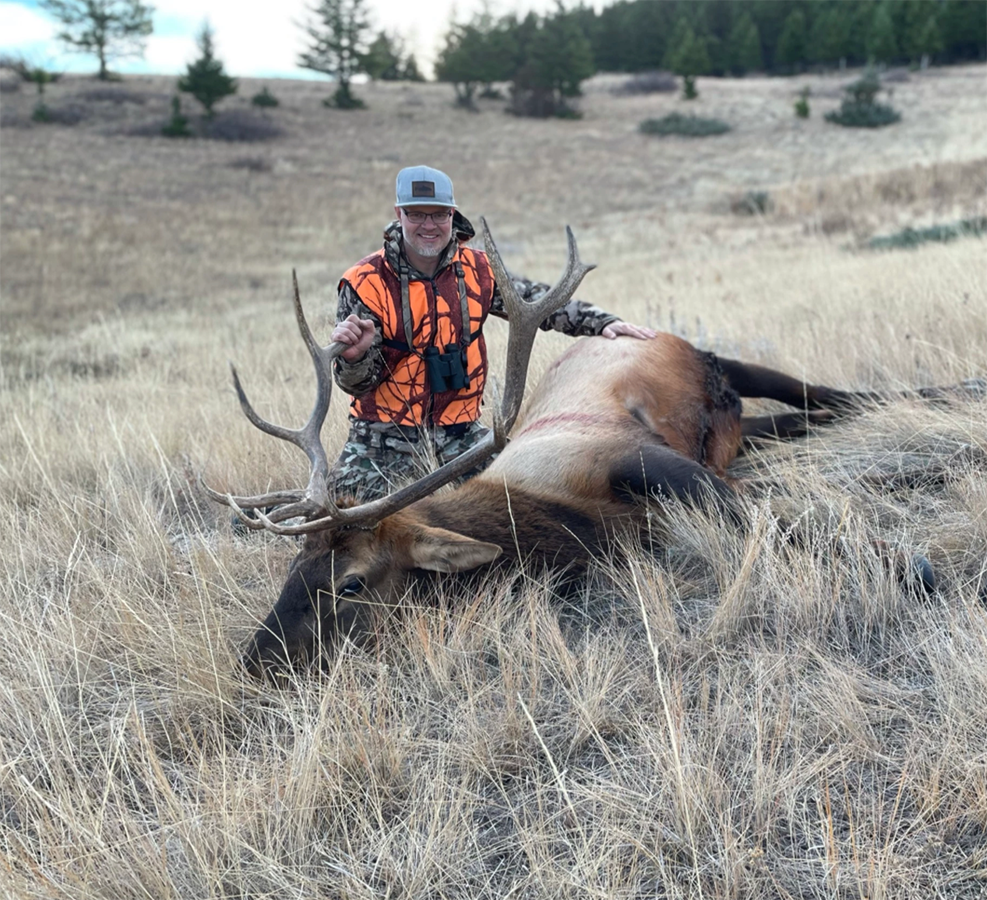
Q: The Land Cruiser is outstanding. Does it have a story?
A: “I’ve always loved the old cruisers from the 1980’s and earlier, and started searching for one fortunately before they became so sought after. I ended up getting mine off of Ebay and have loved driving it ever since. It’s slow and temperamental, (kinda like me), but it’s never let me down and makes a fantastic hunting and fishing rig. I can throw the flycraft raft up on top and be ready to hit the water anytime. My kids are now fighting over who gets to drive it in high school.”
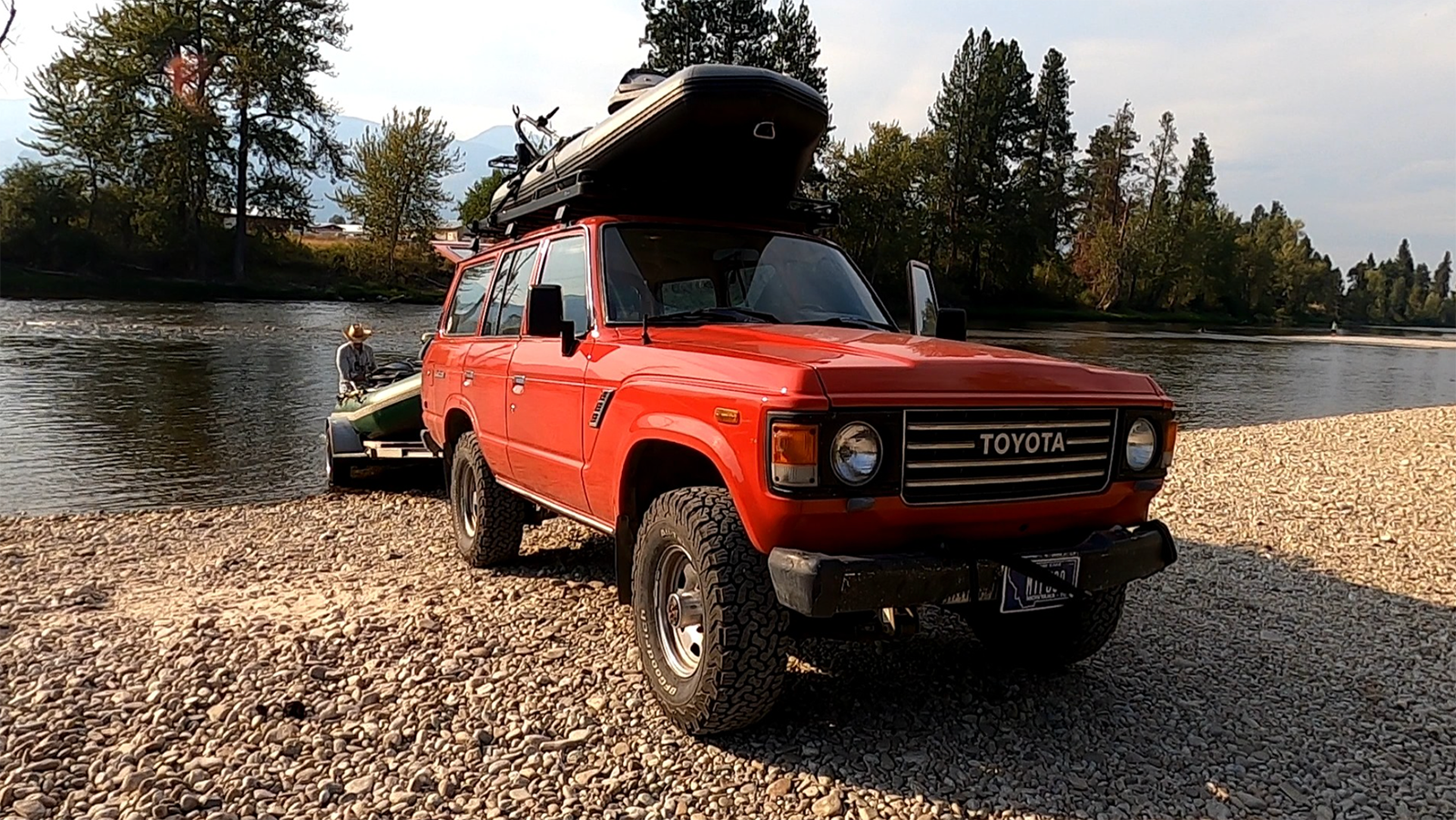
Q: Plein Air —You say: “I became a better artist when I began painting from life, it forced me to really observe and train my eyes to filter out the unnecessary stuff and focus on the major elements.” Can you talk about this process? Can you talk about the need or maybe more so the ability that artists have when it comes to observation of their environments? How do you get yourself into that place/mindset?
A: “I started out painting solely using photographs and didn’t really realize that the photos weren’t capturing the color and subtleties that your eye can pick up. My work looked flat. When I was studying with Christine Verner in Oklahoma she said I need to work from life more, so I started painting still lifes and working with live models. It helped train my eye immensely.”
“When I took the easel outdoors I was completely overwhelmed by all the information and detail I was observing and it was very difficult to not get bogged down. So to overcome this intimidation I forced myself to get out there and only work from life, no photographs for several years. My paintings were terrible at first but eventually I become a fairly proficient plein air painter. Looking back on that formative phase of my career I can see how critical it was to my overall development as a landscape artist. Now that I’m predominately a studio painter I can draw upon the knowledge built during that time and all the moments spent observing since then to create works that hopefully have believability and authenticity.”
“Like I mentioned earlier, when I’m out fishing or hunting I’m constantly evaluating everything with my artist’s eye, taking mental notes and frequently snapping pics with my cell phone to jog the memory. I still paint en plein air but not as often as I probably should, and these days when I do take the easel out its more to capture little color notes or sketches, and not create a finished work.”
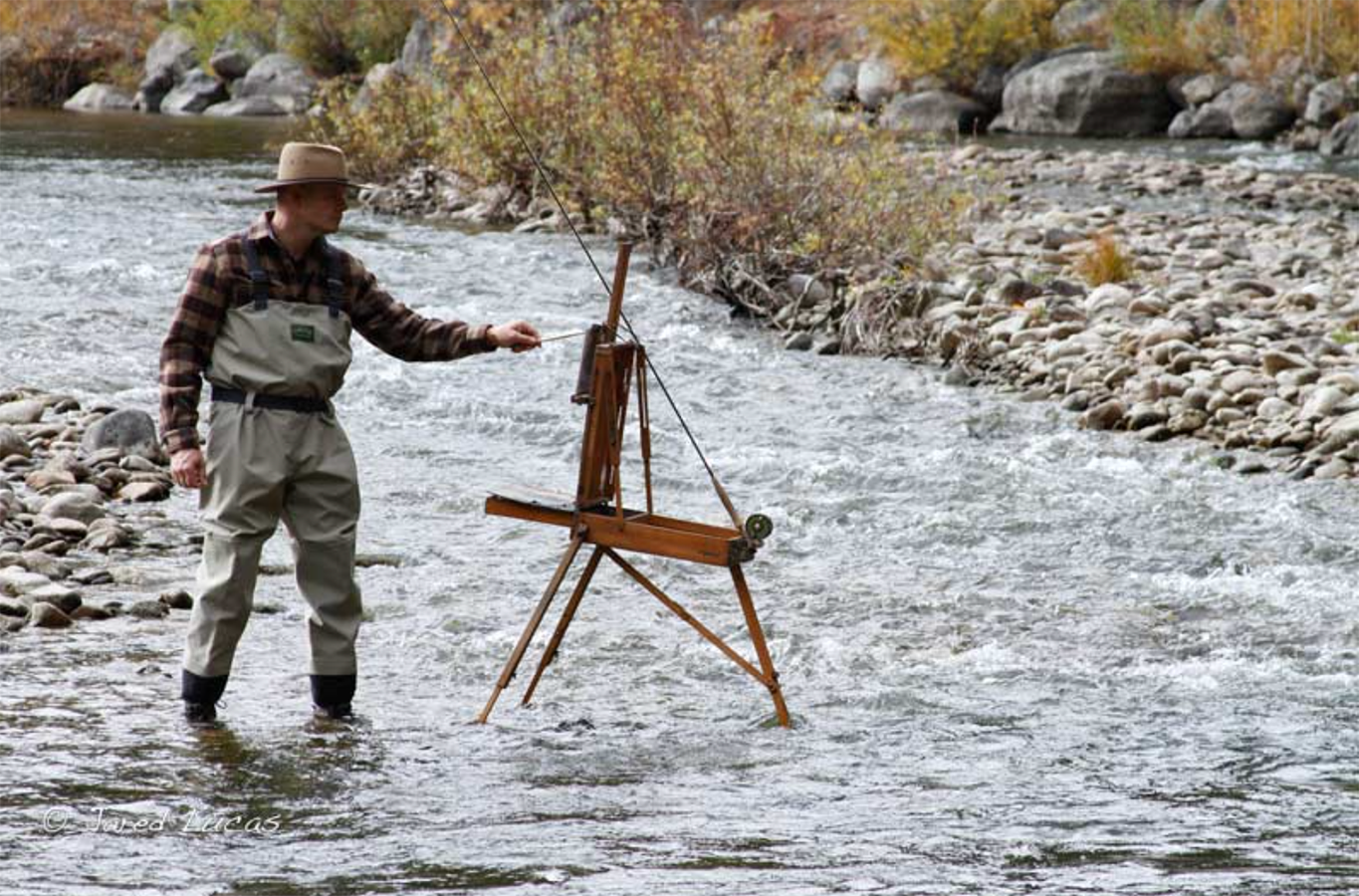
Q: Your painting style is impressionistic and described as tonalist/luminist—which is characterized by the effects of light in landscape. I’m not very articulate in describing artwork, but I know what I’m drawn to. For me the qualities of your painting that pull me in are the moodiness and that light or glow that I can’t really describe but notice immediately. I’ve also heard words like “old world” to describe your work and that feels right; there’s something immediately classic about the style. How would YOU describe your work?
A: “Thanks, I appreciate the kind words and glad my work speaks to you. I often struggle to define my work or what particular school/genre it best fits into. Certainly the Luminists, Hudson River School, Barbizon School, and the Tonalists of the late 1800’s have had a profound influence on my work. I am drawn to artwork that not only catches my eye but touches something deeper within. So in my own work I want to depict those times of day and seasons that resonate with me, bring back memories perhaps, and also just make me slam on the brakes and take notice as the moment is fleeting. Timeless contemplative scenes that pay homage to simple rural life or attempt to capture the sublime, something folks can escape into or imagine themselves within.”
“I want to do it in a way that is uniquely my own and recognizable. I want my work to reflect my time on Earth, a record of places I’ve been and experiences I’ve had and hopefully be inspirational to the viewer.”
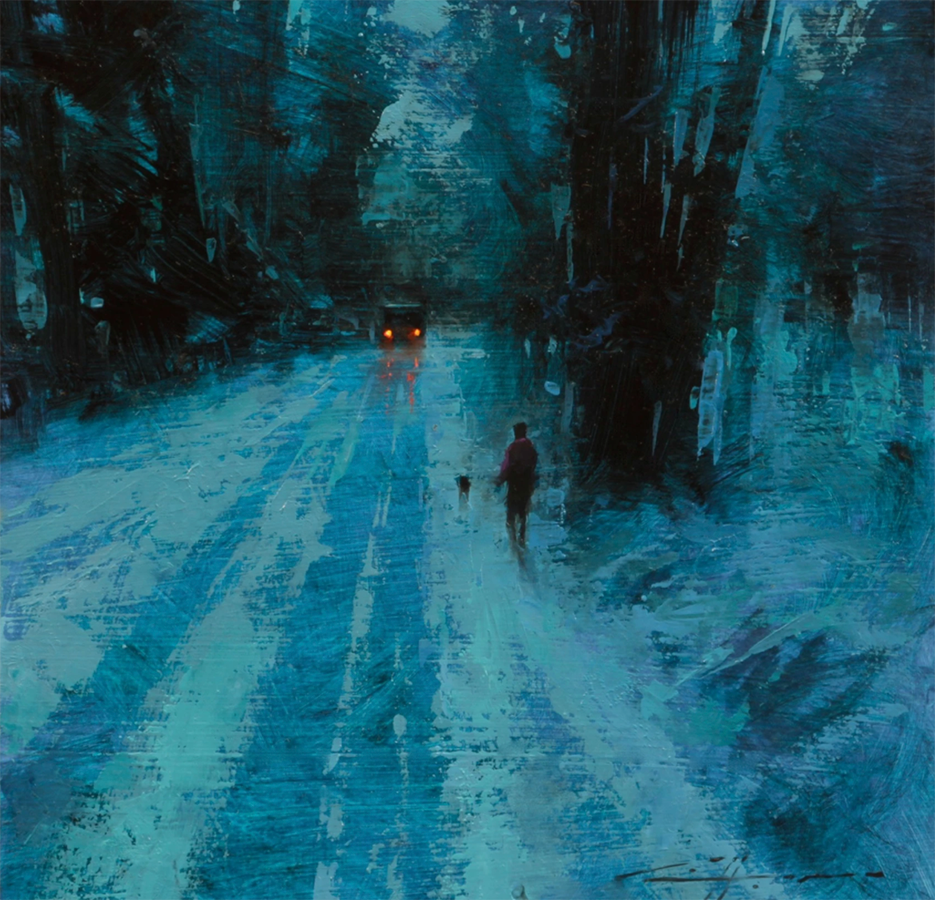
Q: Some of my favorite pieces of yours include: Serenity of the River, Rise and Shine, Flames at Twilight, In the Stillness of Dawn, Evening Catch, Sundown’s Embrace, New Year’s Day, When Days are Short, and In the Moment. What are some of your favorite works and why?
A: “Oh man, that’s tough one. I do have a list of favorites over the years, some of which have never been seen as they’re paintings of my wife and kids. Fortunately I’ve reached a point in my career that I’m able to hang onto some of my favorite pieces, I couldn’t really afford to do that prior to now. Some works have gotten away from me and I wish I could have them back. Some of my favorite works depict scenes that represent memorable moments from my life; settings of sporting pursuits or experiences I’ve had with family and friends on the river or in the field. Others are favorites because I feel they were particularly successful from a technical standpoint or marked an improvement in some way. Others for the way they impacted the folks that view them. I’ve had so many wonderful reactions and comments over the years about how my paintings affected them and for me that is the most gratifying thing an artist can hear. I once had a lady tell me, ‘your artwork makes me remember things I haven’t seen.'”
Q. Favorite artists. I’m always curious to know who inspires those that inspire me. So, who are some of your favorite artists (painters, musicians, writers, etc) and why? Who inspires you?
A: “So many to list but if I want to get fired up to paint wildlife I look at the works of Carl Rungius, for Landscapes it’d be the works of the great Tonalists like George Inness, for figurative and still life subjects Richard Schmid would be at the top of my list. I have eclectic taste in music and listen to all sorts when I’m painting, from classical guitar to classic rock depending on my mood. I’m inspired by so much and maybe a bit ADHD bouncing around from this to that but I admire greatly those that are at the top of their craft and pursuing their passions. Hopefully my work can inspire others as well.”

Q: Your website is cottonfinearts.com. Is this the best place to inquire about your work?
A: “Yes, and I also do the social media thing. Trying to post new works and other projects to my instagram and facebook pages frequently. Folks are also free to reach out to me via cell or email. “(found on website).
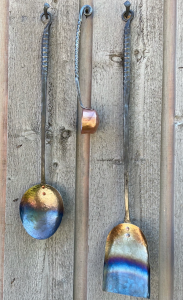
Q: What’s next? Anything on the horizon you can share with us?
A: “I’m working on updating my shop so I can embark on my next career… Brent Cotton blacksmith and blade-maker. Haha, not really, but I do enjoy forging and making knives and various tools in my shop and hope to have more time to do that in between painting deadlines, daddy duties, and getting out chasing trout and game.”
Interview originally published on AllenOutside.com. All Rights Reserved.
"Authors, Artists and Makers Volume 3: George Hill"
A.D. Tinkham



